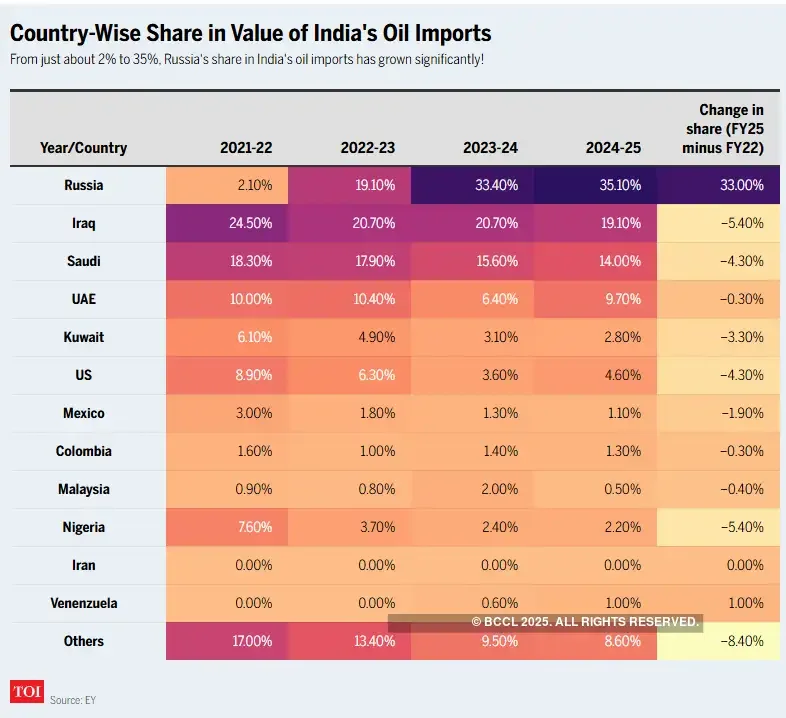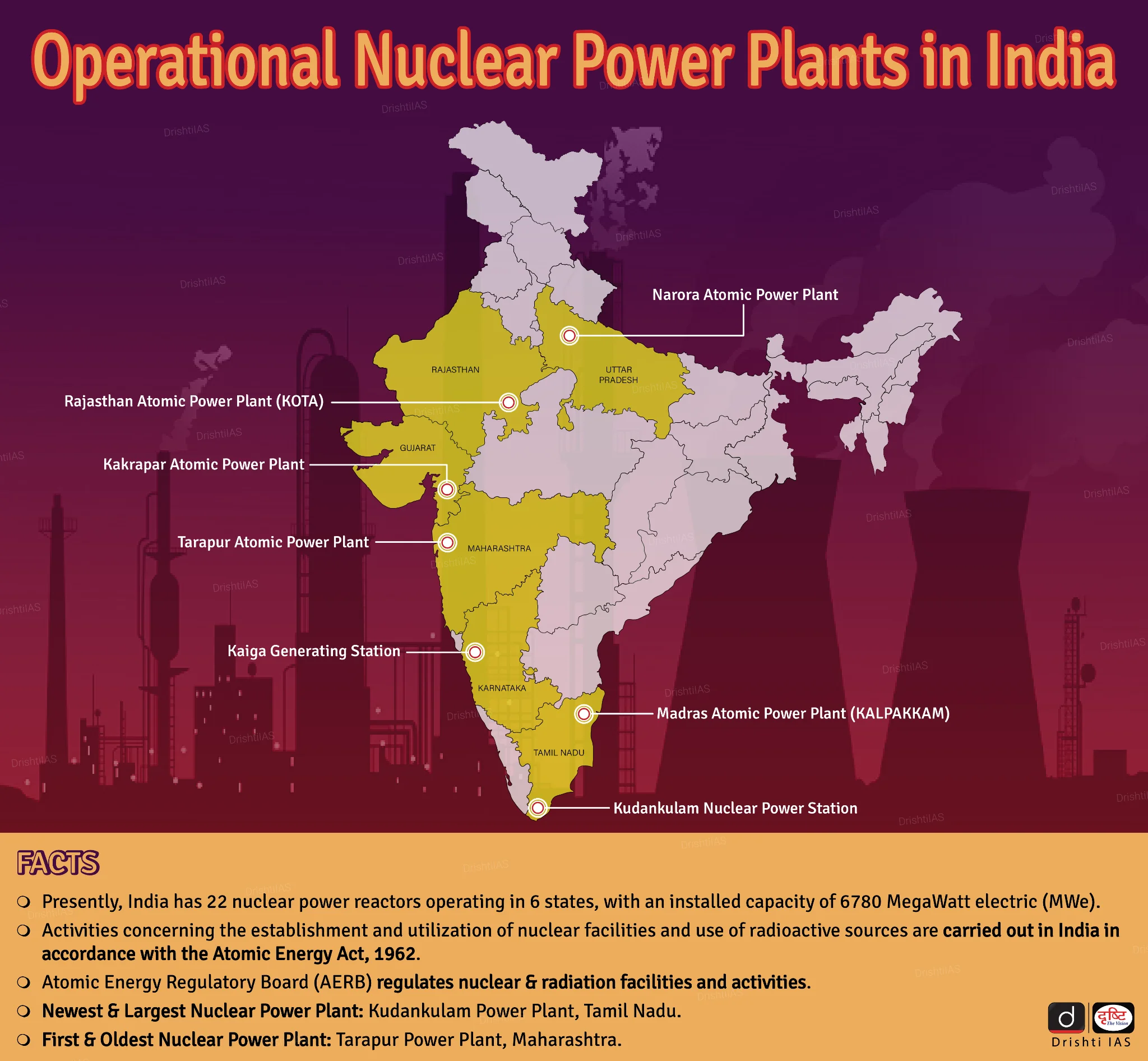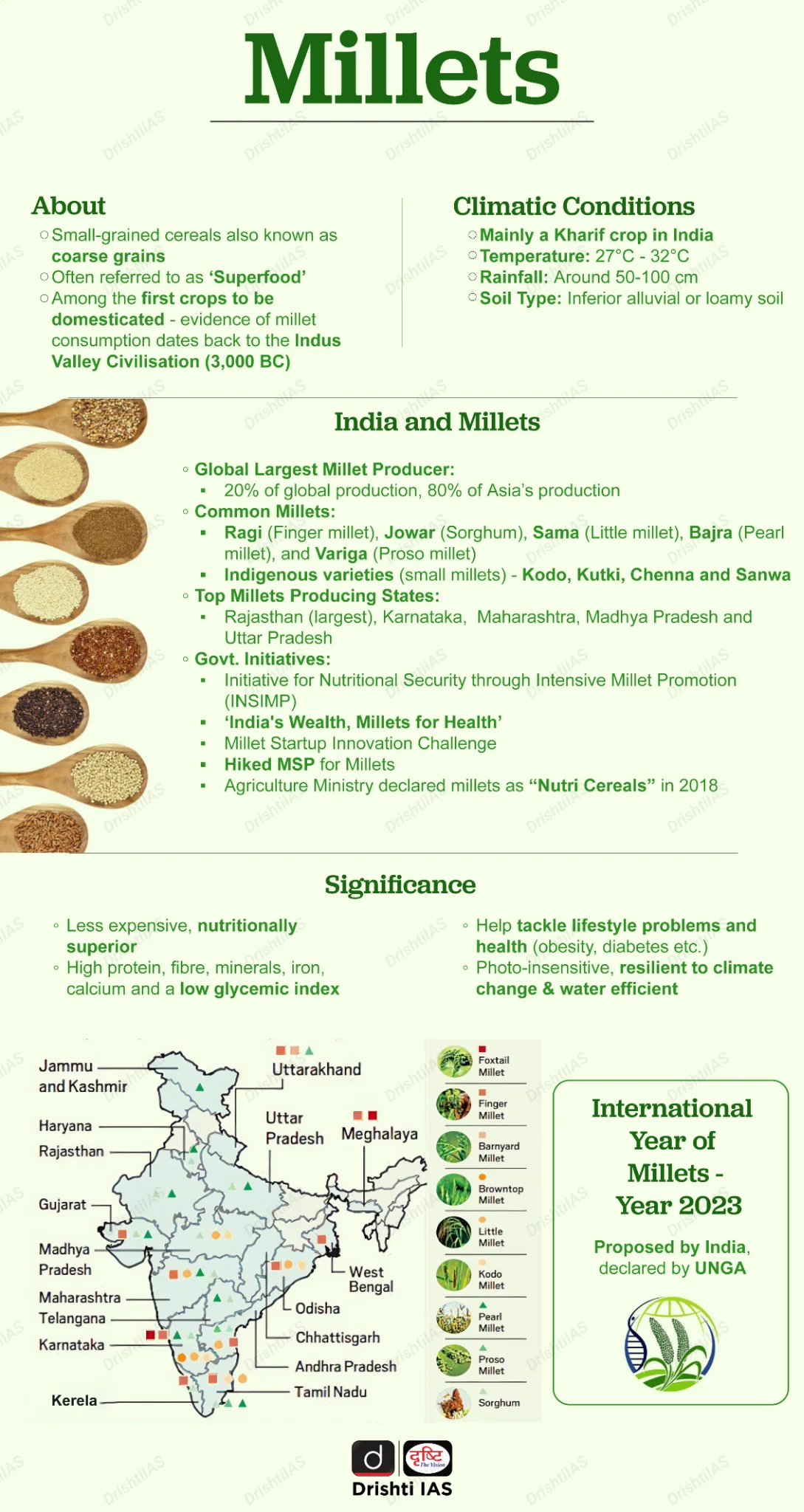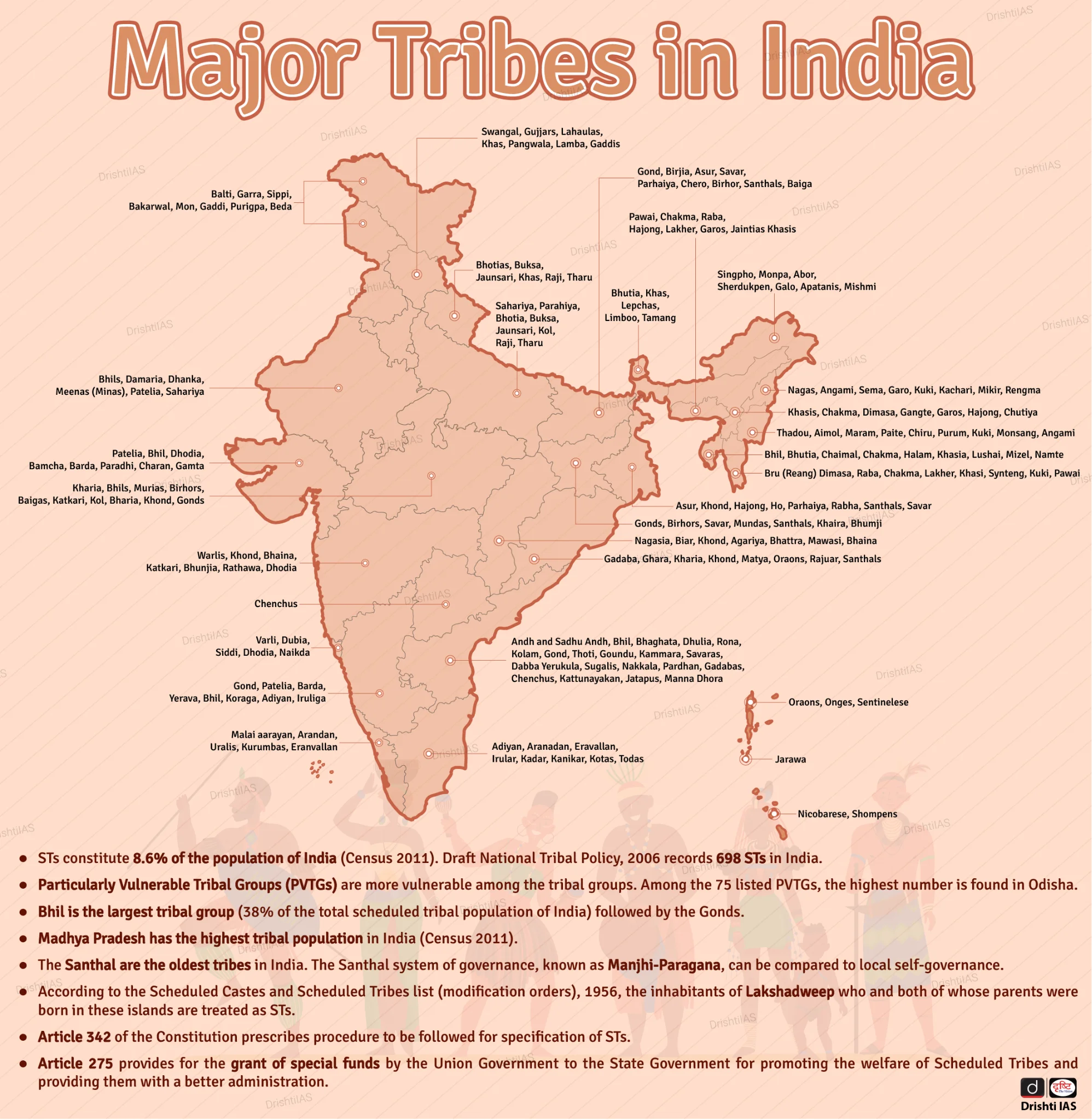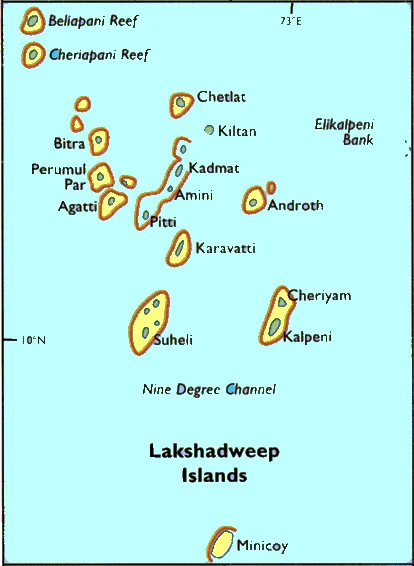International Relations
India’s Concerns on Western Sanctions on Russian Oil
For Prelims: North Atlantic Treaty Organization, Quad, BRICS, Shanghai Cooperation Organisation, Strategic Petroleum Reserves
For Mains: Energy Security and India’s Foreign Policy, Impact of Sanctions on Global South Economies, Geopolitical Dimensions of India’s Oil Imports
Why in News?
India has sharply criticised the proposed US Russian Sanctions Act, 2025, which threatens 500% tariffs on countries importing Russian oil and energy products.
- The move comes alongside strong pressure from North Atlantic Treaty Organization(NATO) which advised India, China, and Brazil to stop buying Russian oil or face 100% secondary sanctions.
- India accused the West of “double standards”, noting Europe still buys Russian energy while pressuring others to stop.
What are Secondary Sanctions?
- About: Secondary sanctions are a type of economic penalty that don’t directly target the country or entity violating international norms, but instead punish third parties, usually other countries, companies, or individuals that continue doing business with the primary sanctions target.
- The goal is to isolate the primary target more completely by discouraging others from engaging with them, even if those third parties aren't violating any international laws themselves.
- Key Features: They reinforce primary sanctions by closing off loopholes and discouraging workarounds.
- Secondary sanctions can impose 100% tariffs, block financial access, and restrict trade even on foreign entities not tied to the sanctioning country.
- Concerns Regarding Secondary Sanctions: They often extend the reach of one country’s laws into the affairs of others which many see as a form of economic coercion.
- Secondary sanctions can strain diplomatic ties, especially if the targeted third party is an ally.
How Significant is Russian Oil to India?
- Strategic Cushioning Amid Global Turbulence: Russian oil, sold at a discount since Western sanctions following the Russia-Ukraine war, 2022, has helped India manage inflation, stabilize its current account deficit, and reduce fuel subsidies.
- By importing discounted crude from Russia, India has saved around USD 13 billion (2022-2024).
- Rising Dependence post-2022: In FY22, Russia accounted for only 2.1% of India’s oil imports. By FY25, this jumped to 35.1%, making Russia the top supplier, ahead of West Asian sources (Qatar, UAE).
- In 2024, India imported nearly 1.9 million barrels/day from Russia, compared to just 0.1 mb/d in 2021.
Why is India Opposing the Russian Sanctions Act and NATO's Tariff Threats?
- Energy Security: India imports over 85% of its oil needs, and Russian crude has been a key source since 2022.
- Excluding Russia, which supplies 10% of global oil, could raise prices to USD 130 per barrel, causing spikes and hurting consumers.
- Double Standards by the West: India points out that many European countries still buy Russian energy, often through third countries. The EU imported 18% of its natural gas from Russia in 2024.
- India argues that the same standards are not applied to the West, questioning the legitimacy and fairness of US and NATO sanctions.
- Threat to Trade Sovereignty: The proposed 100%–500% tariffs would hit all Indian exports to the US, putting its USD 41 billion trade surplus (2024-25) at risk, especially in IT, textiles, and pharma.
- Earlier, in 2019, India had halted Iranian oil imports under similar US secondary sanctions, highlighting the pressure on its economic sovereignty.
- Negotiation Strategy: India views the sanctions threat as a pressure tactic, and is engaging with the US to voice its concerns and seek waivers or exemptions from proposed tariffs.
What Strategies can India Adopt to Ensure Energy Security Amid Geopolitical Pressure?
- Diversification of Energy Imports: India now sources crude from 40 countries, up from 27, with rising imports from the US and Brazil.
- It is also increasing oil shipments from Saudi Arabia, Iraq, and African nations to reduce dependence on Russia.
- India should strengthen ties with the Quad, BRICS, and Shanghai Cooperation Organisation (SCO), SAARC and BIMSTEC for energy resilience.
- It must also use platforms like the G20 and strategic dialogues (e.g., 2+2 meetings) with the US and EU to seek sanctions waivers.
- Build Strategic Oil Reserves: Accelerate expansion of India's Strategic Petroleum Reserves (SPR) to act as a buffer during global supply disruptions.
- Sign forward-looking agreements with reliable suppliers for consistent delivery at predictable prices.
- Boost Domestic Energy Production: Increase investment in domestic oil and gas fields through policy support and public-private partnerships. Scale up ethanol blending, biofuels, and hydrogen production to reduce crude oil reliance.
- Continue large-scale deployment under the National Solar Mission and green hydrogen initiatives. Improve storage and transmission infrastructure to support renewable integration.
|
Drishti Mains Question: India flags the West for “double standards” in energy trade with Russia. Analyze this criticism and its relevance in shaping India's geopolitical stance. |
UPSC Civil Services Examination, Previous Year Questions (PYQs)
Prelims
Q.1 With reference to furnace oil, consider the following statements: (2020)
- It is a product of oil refineries.
- Some industries use it to generate power.
- Its use causes sulphur emissions into the environment.
Which of the statements given above are correct?
(a) 1 and 2 only
(b) 2 and 3 only
(c) 1 and 3 only
(d) 1, 2 and 3
Ans: (d)
Q.2 The term ‘West Texas Intermediate’, sometimes found in news, refers to a grade of (2020)
(a) Crude oil
(b) Bullion
(c) Rare earth elements
(d) Uranium
Ans: (a)
Mains:
Q. The question of India’s Energy Security constitutes the most important part of India’s economic progress. Analyse India’s energy policy cooperation with West Asian countries. (2017)
Q. “Access to affordable, reliable, sustainable and modern energy is the sine qua non to achieve Sustainable Development Goals (SDGs)”.Comment on the progress made in India in this regard. (2018)


Science & Technology
Advancing India’s Nuclear Energy Generation
For Prelims: Union Budget 2025–26, Nuclear Power, COP28, Small Modular Reactors (SMR), Prototype Fast Breeder Reactor, Nuclear Power Corporation of India Limited (NPCIL), Civil Liability for Nuclear Damage Act, 2010, Pressurised Heavy Water Reactors (PHWRs), Uranium, Nuclear Suppliers Group, Convention on Supplementary Compensation (CSC, 1997).
For Mains: Importance of nuclear energy for India's development and key challenges in Its nuclear strategy. Reforms needed for a sustainable future.
Why in News?
The Union Budget 2025–26 set an ambitious target of 100 GW nuclear power capacity by 2047 positioning nuclear energy as a key pillar in achieving Viksit Bharat (2047) and net-zero emissions by 2070.
- This shift requires comprehensive reforms in the legislative, financial, and regulatory frameworks to address existing challenges.
How is India Advancing in its Nuclear Power Development?
- Historical Overview: India began its nuclear journey early with Asia’s first research reactor, Apsara (1956), and power reactors at Tarapore (1963). In 1954, Dr. Homi Bhabha, the architect of India's nuclear programme, presented a target of generating 8 GW of nuclear power by 1980.
- Despite international hurdles, India successfully indigenised the 220 MW Pressurised Heavy Water Reactor (PHWR), first employed in Rajasthan and later replicated at Narora, Kaiga, and Kakrapar.
- Current Capacity & Future Potential: India’s present nuclear power capacity is 8.18 GW, with an ambitious goal of reaching 100 GW by 2047. This will be a critical part of India’s strategy to become a developed country and achieve net-zero emissions by 2070.
- Global Partnerships and Developments: India endorsed the COP28 declaration to triple global nuclear energy capacity. India aims to engage with international partners like France and the U.S. to accelerate nuclear power projects.
What is the Significance of Nuclear Energy for India’s Development?
- Energy Security: India Nuclear power can play a crucial role in helping India meet its energy needs, which are projected to quadruple by 2047, by providing a reliable 24/7 power supply.
- Small Modular Reactors (SMR) and microreactors provide clean energy to remote areas without grid reliance, while nuclear desalination helps tackle water scarcity in coastal regions.
- Supporting Industrial Growth: Nuclear reactors can support energy-intensive industries (steel, cement, data centers) that need reliable, high-capacity power.
- Small Modular Reactors (SMR) can support remote industries, hydrogen production, and desalination.
- Geopolitical Leverage: Indigenous advances like the Prototype Fast Breeder Reactor (Kalpakkam) showcase technological strength, reducing strategic vulnerabilities and improving bargaining power in global energy deals.
- Disaster Resilience: Nuclear energy offers resilient supply during natural disasters or geopolitical disruptions. They remain reliable during recent grid disruptions.
Small Modular Reactors (SMRs)
- Small modular reactors (SMRs) are advanced nuclear reactors with a power output of up to 300 MW (e) per unit, about one-third the capacity of conventional nuclear power reactors.
- SMRs are characterized by being:
- Small: Significantly smaller in size compared to traditional nuclear reactors.
- Modular: Designed for factory-assembly and transport, allowing systems and components to be delivered as complete units for installation.
- Reactors: Using nuclear fission to generate heat, which is then converted into electricity. Types of Reactors:
- Micro Reactors: 1 MW to 20 MW, Can fit on a flatbed truck, mobile and deployable.
- Small Modular Reactors (SMRs): 20 MW to 300 MW, Can be scaled up or down by adding more units.
- Full-Size Reactors: 300 MW to 1,000+ MW, Provides reliable, emissions-free baseload power.
What are the Challenges in India’s Nuclear Energy Generation?
- Legislative and Regulatory Hurdles: Atomic Energy Act, 1962 reserves nuclear power generation solely for the government, with Nuclear Power Corporation of India Limited (NPCIL) as the exclusive operator, limiting private sector participation.
- Civil Liability for Nuclear Damage Act, 2010 (CLNDA) imposes liability on both operators and suppliers, deterring foreign countries like the US and France.
- The Atomic Energy Regulatory Board (AERB), subordinate to the Department of Atomic Energy, lacks full autonomy.
- Financing and Cost Challenges: Indigenised Pressurised Heavy Water Reactors (PHWRs) cost around USD 2 million/MW, nearly double that of coal plants; foreign reactors are even costlier.
- Despite being low-carbon, nuclear energy isn’t classified as “renewable”, making it ineligible for tax benefits and green financing instruments.
- Fuel Supply Constraints: India’s limited uranium reserves and Nuclear Suppliers Group (NSG) non-membership hinder fuel supply, and despite the 2008 NSG waiver, agreements with France and the US remain slow.
- Waste Management Issues: India has systems in place for managing nuclear waste, but lacks a permanent deep geological repository for high-level waste.
|
Click Here to Read: Civil Liability for Nuclear Damage Act, 2010 Click Here to Read: Convention on Supplementary Compensation for Nuclear Damage (CSC), 1997 |
What Steps can be Taken to Promote Nuclear Energy Generation in India?
- Legislative & Regulatory Reforms: Amend the Atomic Energy Act (1962) to permit private participation in nuclear power generation, and establish clear ownership models.
- Revise the CLNDA (2010) to limit supplier liability, and align with Convention on Supplementary Compensation (CSC, 1997) to enhance investor confidence.
- Make AERB a statutory authority for transparent safety oversight.
- Financing & Investment Incentives: Classify nuclear power as "renewable energy" to enable access to green bonds, tax incentives, and low-cost climate financing.
- Allow FDI up to 49% in nuclear projects to retain Indian control, and promote joint ventures.
- Accelerate Reactor Deployment: Standardize the 220 MW PHWR design for use in Bharat SMRs to reduce commissioning time and make 5 SMRs operational by 2033. Simultaneously, scale up NPCIL's plans for the 700 MW PHWR.
- Fast-track the Jaitapur Nuclear Power Plant (JNPP) deal with France and revive US negotiations for AP1000 reactors in Kovvada, Andhra Pradesh.
- Fuel Security & Supply Chain: Secure uranium and thorium supplies through long-term deals with Canada, Kazakhstan, and Australia, and accelerate R&D on thorium reactors like BHAVINI’s PFBR.
- Develop indigenous supply chains and set up nuclear industrial parks to localize key technologies.
Conclusion
- Nuclear energy is vital for India’s energy security, industrial growth, and climate goals. Achieving 100 GW by 2047 requires private participation, legislative reforms, and global collaborations. Addressing liability laws, financing hurdles, and fuel supply constraints will be key. Strategic policy shifts can position nuclear power as a cornerstone of Viksit Bharat and net-zero commitments.
|
Drishti Mains Question: Enumerate the major challenges in expanding nuclear energy generation in India and suggest possible solutions. |
UPSC Civil Services Examination, Previous Year Question (PYQ)
Prelims
Q. In India, why are some nuclear reactors kept under “IAEA safeguards” while others are not? (2020)
(a) Some use uranium and others use thorium
(b) Some use imported uranium and others use domestic supplies
(c) Some are operated by foreign enterprises and others are operated by domestic enterprises
(d) Some are State-owned and others are privately owned
Ans: (b)
Q. Consider the following statements: (2017)
- The Nuclear Security Summits are periodically held under the aegis of the United Nations.
- The International Panel on Fissile Materials is an organ of the International Atomic Energy Agency.
Which of the statements given above is/are correct?
(a) 1 only
(b) 2 only
(c) Both 1 and 2
(d) Neither 1 nor 2
Ans: (d)
Mains
Q. With growing energy needs should India keep on expanding its nuclear energy programme? Discuss the facts and fears associated with nuclear energy. (2018)
Q. Give an account of the growth and development of nuclear science and technology in India. What is the advantage of the fast breeder reactor programme in India? (2017)


Facts for UPSC Mains
India’s Millet Standards Recognised at Codex Alimentarius Commission
Why in News?
India’s leadership in developing a group standard for whole millet grains was appreciated during the 88th Session of the Executive Committee of the Codex Alimentarius Commission (CAC) 2025, held at the Food and Agriculture Organization (FAO) headquarters in Rome, Italy.
What is the Codex Alimentarius Commission (CAC)?
- About: CAC is an international food standards body established jointly by the FAO and the World Health Organization (WHO) in 1963 with the objective of protecting consumer's health and ensuring fair practices in food trade.
- The CAC has 189 members. India joined in 1964.
- Codex Alimentarius: The Codex Alimentarius, or "Food Code", is a collection of standards, guidelines, and codes of practice adopted by the CAC.
- It sets standards for all major foods (processed, semi-processed, or raw) and covers areas like hygiene, additives, residues, contaminants, labelling, and inspection.
- Codex standards guide food safety trade disputes under the World Trade Organization (WTO) Agreement on the Application of Sanitary and Phytosanitary Measures (SPS Agreement).
- India and CAC: India actively engaged in discussions around the Codex Strategic Plan 2026–2031, advocating for SMART (Specific, Measurable, Achievable, Relevant, Time-bound) Key Performance Indicators.
- Since 2014, India has chaired the Codex Committee on Spices and Culinary Herbs, and led the development of global standards for millets, fresh dates, and India will also serve as co-chair in new work proposals to develop standards for fresh turmeric and broccoli. It also promoted Codex Trust Fund use for capacity building.
What are Millets, and How is India Leading their Promotion?
- Millets: Millets, also known as Shree Anna, are small cereal grains grown mainly as a Kharif crop and belong to the Poaceae (grass) family.
- Significance: The United Nations General Assembly, based on a proposal by India, declared 2023 as the International Year of Millets (IYM).
- Millets are more nutritious than wheat and rice, being rich in protein, vitamins, and minerals. They are gluten-free with a low glycemic index, suitable for celiac and diabetic patients.
- As climate-resilient crops, millets require less water and can grow in poor soils, making them ideal for sustainable agriculture.
- India’s Standards on Millets: The Food Safety and Standards Authority of India (FSSAI) has framed group standards for 15 types of millets, specifying 8 quality parameters i.e., maximum limits for moisture content, uric acid content, extraneous matter, other edible grains, defects, weevilled grains, immature grains, and shriveled grains.
- These standards form an important foundation for developing global standards.
- India’s Position in Millets Production: India is the largest producer of millets, contributing 38.4% of global production (FAO, 2023).
- India grows a wide range of millets including sorghum (jowar), pearl millet (bajra), finger millet (ragi) and others like foxtail, barnyard, kodo, and proso millet.
- The total area under millet cultivation in FY24 was 12.19 million hectares, producing 15.38 million metric tonnes.
- Rajasthan leads in both area and production, followed by Uttar Pradesh, Karnataka, and Maharashtra.
- Exports: India exported 1.46 lakh metric tonnes of millets in FY24, earning USD 70.89 million. Key export destinations include the UAE, Saudi Arabia, USA, Japan, and Nepal.
- India’s Initiatives to Promote Millets:
- Production Linked Incentive Scheme for Millet-Based Products (PLISMBP) (2022–2027): The PLISMBP incentivizes companies producing Ready-to-Eat/Cook products with ≥15% millet content.
- Sub-Mission on Nutri-Cereals (Millets) under NFSM: Covers 28 States and 2 UTs, promoting major, minor, and pseudo-millets like buckwheat and amaranth.
- It provides farmers with incentives for seed production, better farming techniques, tools, and awareness training.
- Nutrition and Public Distribution: Millets added under TPDS (Targeted Public Distribution System), ICDS (Integrated Child Development Services), Mid-Day Meal Scheme, and Poshan Abhiyan.
- FSSAI’s Eat Right Campaign: Promotes millets as part of a balanced diet.
- Rashtriya Krishi Vikas Yojana (RKVY): Under RKVY, states have the flexibility to promote millets based on local priorities.
- States like Assam, Bihar, Odisha, Karnataka, and others have also launched their own Millet Missions.
|
Drishti Mains Question: India’s efforts to promote millets go beyond domestic production to setting global standards. Discuss. |
UPSC Civil Services Examination Previous Year Question (PYQ)
Prelims
Q. With reference to ‘Initiative for Nutritional Security through Intensive Millets Promotion’, which of the following statements is/are correct? (2016)
- This initiative aims to demonstrate the improved production and post-harvest technologies, and to demonstrate value addition techniques, in an integrated manner, with a cluster approach.
- Poor, small, marginal and tribal farmers have a larger stake in this scheme.
- An important objective of the scheme is to encourage farmers of commercial crops to shift to millet cultivation by offering them free kits of critical inputs of nutrients and micro irrigation equipment.
Select the correct answer using the code given below:
(a) 1 only
(b) 2 and 3 only
(c) 1 and 2 only
(d) 1, 2 and 3
Ans: (c)
Mains
Q. Explain the role of millets for ensuring health and nutritional security in India. (2024)


Rapid Fire
Hatti Tribe
In Himachal Pradesh, two brothers from the Hatti tribe married one woman in a polyandrous marriage, a traditional practice still seen in some Himalayan tribal communities.
The Hatti Community:
- About: The Hatti are a close-knit tribal community residing along the Himachal Pradesh–Uttarakhand border.
- Their name comes from their traditional occupation of selling crops and meat at local haats (marketplaces).
- The Hattis have two main clans—Trans-Giri (in Himachal Pradesh) and Jaunsar Bawar (in Uttarakhand).
- They were granted Scheduled Tribe status in August 2023.
- Polyandry: Locally known as “Jodidara” or “Jajda”, is a traditional practice among the Hatti community where brothers marry the same woman.
- It originally aimed to prevent land fragmentation and maintain family unity.
- Though less common today, it continues to hold cultural significance within the community.
- Polyandry is illegal under Indian law, but the Himachal Pradesh revenue law has upheld the Hatti tribe's tradition of Jodidara, allowing them to continue the practice under customary tribal law.
- Polyandry is a type of polygamy in which a woman has multiple husbands simultaneously.
- Traditional Council: The Hatti community is governed by a local body called the Khumbli, which handles social issues and community decisions.
| Read more: Securing the Future for Indian Tribes |


Rapid Fire
Death of Cheetah at Kuno National Park
An 8-year-old Namibian female cheetah, Nabha, died at Kuno National Park (KNP) in Madhya Pradesh due to injuries sustained during a likely hunting attempt.
- Project Cheetah:
- About: Cheetah Reintroduction Project (Project Cheetah) was launched in 2022, with the aim to reintroduce cheetahs to India (declared extinct in 1952) as part of global cheetah conservation efforts.
- Implementing Agencies: National Tiger Conservation Authority (NTCA), Madhya Pradesh Forest Department, and Wildlife Institute of India (WII).
- Implementation: Phase 1 involved translocating cheetahs from Namibia (2022) and South Africa (2023) to Kuno National Park, Madhya Pradesh.
- Under Phase-2 of the Project India is considering sourcing cheetahs from Kenya due to similar habitats.
- Cheetahs will be translocated to Kuno National Park and Gandhi Sagar Wildlife Sanctuary (Madhya Pradesh).
- Under Phase-2 of the Project India is considering sourcing cheetahs from Kenya due to similar habitats.
| Read More: One Year of Project Cheetah |


Rapid Fire
UK Issues Sanctions on Global Migrant Smuggling Networks
In a global first, the UK has launched a sanctions regime specifically targeting individuals and networks involved in illegal migrant smuggling across the world.
- The regime targets gangs, middlemen, and enablers involved in cross-border illegal immigration activities. Sanctions include asset freezes, travel bans, and cutting access to the UK financial system.
- The initiative aims to disrupt smuggling operations, though experts remain skeptical about its effectiveness without international cooperation.
- Migrant Smuggling: UN Protocol against the Smuggling of Migrants by Land, Sea and Air, defines migrant smuggling as the act of facilitating a person’s illegal entry into a country of which they are not a national or permanent resident, in exchange for financial or material benefit.
- It is a crime focused on profit, not humanitarian reasons, and undermines the sovereignty of states over their borders.
- Unlike human trafficking, which involves exploitation, migrant smuggling focuses on profiting from illegal border crossings.
- Migrant smuggling involves crossing national borders, trafficking can happen within one country.
- Smuggled migrants can later become trafficking victims if deceived or forced into exploitation.
| Read more: Menace of Illegal Migration |


Place In News
Bitra Island
The government has initiated the acquisition of Bitra Island in Lakshadweep for defence purposes.
Bitra Island:
- About: It is the smallest inhabited island in the Union Territory of Lakshadweep.
- Geography and Location: Situated at 11°36′N, 72°11′E, Bitra lies about 483 km (261 nautical miles) from Kochi, the gateway to Lakshadweep.
- It is part of the Aminidivi subgroup and spans 0.57 km in length and 0.28 km at its widest.
- Climate : The climate of Bitra closely resembles that of Kerala.
- Hot period: March to May, temperatures range from 25°C to 35°C.
- Annual Rainfall: 1600 mm.
- Lagoon and Marine Ecosystem:It is surrounded by a vast lagoon area of 45.61 sq km, supporting rich marine biodiversity.
- Population and Lifestyle: As per the 2011 census , it has a population of 271, mostly dependent on fishing and coconut cultivation.
- Strategic Significance: Bitra is strategically located near major shipping lanes and is set to host a defense establishment, complementing naval bases at Kavaratti (INS Dweeprakshak) and Minicoy (INS Jatayu).
| Read more: Lakshadweep Islands |



